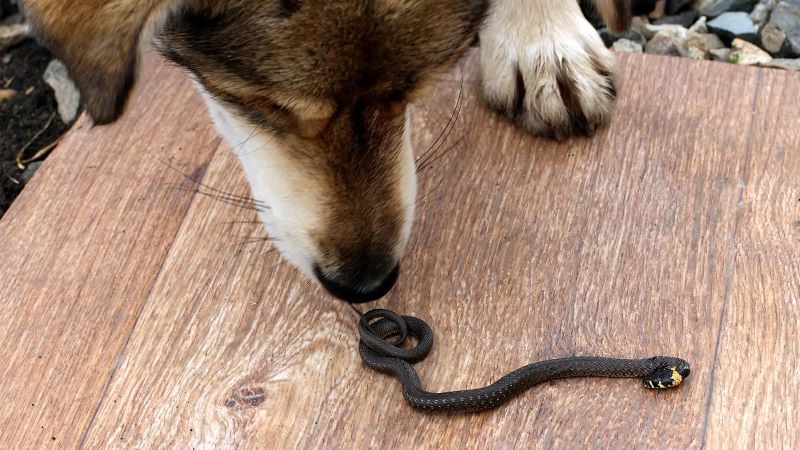Last week, I was enjoying my first cup of coffee and a little fresh air when my dog, Hattie, came up onto the deck looking a little strange. I rubbed the sleep out of my eyes and looked again. Her snout was swollen. When I touched it, the skin there was taut and hard. What in the world, I thought. I had not heard her yelp or seen her get into a scuffle with anything. Could a bee have stung her? Could she have eaten something she was allergic to? Could a snake have bitten her?
Of course, the vet was closed. So, for the next hour, I kept a close eye on Hattie. I gave her some Benadryl and monitored her breathing. If she had trouble breathing or other symptoms appeared, I was going to take her to the emergency vet. Luckily, her condition remained the same and when the vet clinic opened my husband took her in. He told me by the time he arrived at the clinic her eyes had started to swell.
The vet determined it had been a snake bite. There was a spot below her lip that was bleeding and was most likely a puncture site. She thought perhaps the snake had gotten Hattie with just one fang. The swelling was most certainly a result of the venom coursing through her blood. So she gave Hattie a couple of shots (one was an anti-inflammatory immunosuppressant and one was an antihistamine). She also sent her home with antibiotics and painkillers.
Snake Bite Tips
That was a pretty crazy start to our day! Thankfully Hattie is completely healed now, but I have to admit, I haven’t stopped watching her like a hawk when she goes out in the backyard. I never imagined it would happen to us, and you may not have thought about it, or it may be one of your greatest fears! Either way, it’s a good time of year to brush up on some DOs and DON’Ts for if/when you suspect your dog has been bitten.
DON’T attempt to catch the snake or interact with it in any way. It may bite you in the process.
DO take note of the size, color patterns, and presence/absence of a rattle, so you can try to identify the type of snake once you arrive at the vet.
DON’T cut X’s over the fang marks on your dog and try to suck the venom out. It is not possible to suck with enough force to remove the venom.
DO wrap a constricting band on the affected limb if the bite is on your dog’s leg. Make it snug, but not excessively tight. This will slow the spread of venom.
DON’T wait too long to head to the vet clinic.
DO go as soon as possible to an emergency vet or your family veterinarian. Time is of the essence when a snakebite is suspected or confirmed!
Signs of a Snake Bite
Be aware of the signs of a snake bite so you know when a trip to the vet is required!
- Puncture wound (may or may not bleed)
- Swelling
- Difficulty breathing
- Dog is acting anxious or uncomfortable
- Panting or drooling
Snake Bite Prevention for Your Dog
Prevention is also worth considering, especially during the summer when snakes are out of hibernation.
- Keep your dog on a leash when walking outside of your yard and make sure to back away quickly if he seems particularly curious about something off the path.
- Keep nighttime walks to a minimum as visibility will decrease and you may not be able to see a snake on the path.
- Avoid rocky areas or places with dense brush where snakes might be hiding.
- Keep your yard clean of items that might attract natural food sources of snakes such as rodents. Pick up food and birdseed that has fallen on the ground and keep your grass cut short.
- Snakes can swim, so keep an eye out when taking your pup for a swim in the water.
Hopefully, you will never have to worry about the DOs and DON’Ts of snakebites, but now you know just in case!

